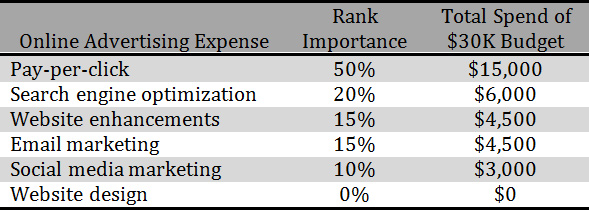It depends. Helpful, huh?
To get a better answer than that the first question to ask is how much should your total marketing budget be. Conventional business wisdom tells us marketing budgets should be set at 2%-10% of revenue. You will often see recommendations that the numbers come in closer to the 5% range. This percentage can have a wide swing depending on your industry, total revenue, where your “business life cycle” is, product launch schedule, etc. However, to make the best choice possible, the most important thing to understand is the profitability of your business.
Once you have your total marketing budget determined, you can start sorting out how much of that money to spend online and where to spend it. First consider how much of your revenue is generated online versus offline and what the growth possibilities are for each sector. Here are a few possible scenarios:
- None is online business: If none of your business is generated online then it is unlikely that any of your marketing budget would be spent online unless it was a branding strategy. If you are wanting to go online for the first time then often this will take a large chunk of your marketing budget since the startup costs of developing websites, branding campaigns, web copy and other assets is often much more expensive to create than to maintain.
- About 20% or less online, but it could be a lot more: When you have market share potential online then you need to determine how much it would cost you to gain more offline sales versus online sales. Just because you can gain more market share online doesn’t mean you should if you can gain more market share at a more cost effective rate through your offline efforts. If you have saturated the offline market then you can afford to go all-in on your online marketing budget.
- 100% or close to it is online: Of course, most of the budget will be spent online. However, you need to know what your cost per conversion is for each of your online marketing efforts. You also need to have a sharp pencil on your profitability. If you spend $10 to gain a $50 transaction that has a 20% profit then that wouldn’t make much sense, but if you have a 40% profit margin then you are spending $10 to make $20. Keep in mind that your cost per conversion will be different for all of your online marketing efforts. AdWords conversions may cost you more or less than email marketing conversions, for example. Since most of your business is online already, you have to understand these numbers to make the best possible choices.
After considering your current sales and your potential growth both online and offline, you must determine how much you should you spend on each area of digital marketing. For the sake of this article let’s use this scenario:
Total Annual Revenue: $800,000
Online vs. offline sales: 70% – 30%
Total Marketing Budget: $40,000 (5% of sales)
Online Marketing Budget: $30,000 (75% of budget)
A few of the major expenses to consider in your online marketing budget can include search engine optimization, website design, website redesign/enhancements, social media marketing, and pay-per-click advertising. Each of these areas will have a different return on investment (ROI). The ROI is something that you will want to track closely. The better you understand past ROI the better you will be at predicting future ROI.
For example, if you know that for every $1 you spend in pay-per-click ads you make $2.20 and for every $1 you spend on email marketing you make $1.50 then it is easy to see where more of the budget should go. As you gather more data over the years this ROI should become more and more clear. If you don’t have solid ROI numbers then you must use anecdotal evidence (your best guess based on past experiences) to make your spending choices.
I suggest starting by listing all of the area you would like use in your online marketing efforts. Then rank each of these areas based on your anticipated ROI. Keep in mind that some efforts will have a short-term ROI and others will have a long-term ROI. For example, search engine optimization can have great long-term ROI, but poor short-term ROI whereas pay-per-click can have a great short-term ROI and poor long-term ROI. Once your rankings are complete it is time to determine how much more important number 1 is than number 2 and so on. If you do this on a percentage basis then your marketing budget should become clearer. Here is a sample of what this would look like:

By first thinking through how much growth you want to see in your online sales to determine your overall online marketing budget and then considering the ROI of the potential marketing channels available to you, the choices should become clearer. Ultimately, the answer of how much of your marketing budget you should spend online is a very individual choice for every business. So maybe the best answer really is, “It depends.”

